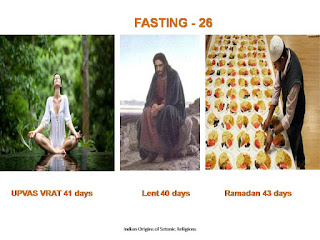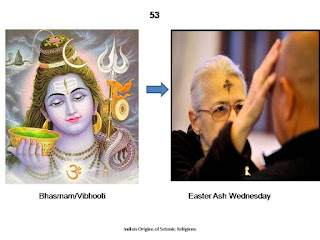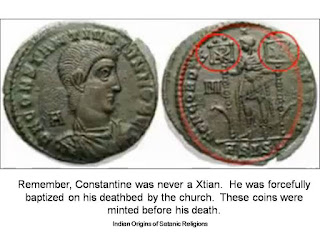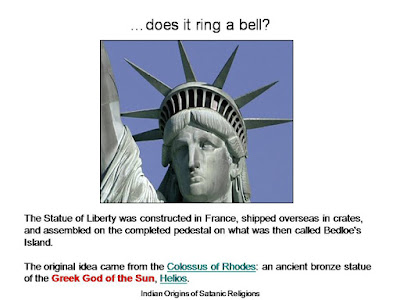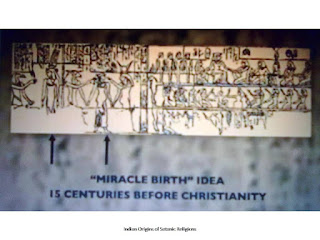"He who knows one religion
knows none"--Max Mueller
The mockery and ridicule that
runs riot in the Facebook atheist page "Freethinkers" is what
actually prompted me to study other religions, to check for myself if what is
mocked around in this group is actually mentioned in the Holy books of the
Muslims and Christians.
Below are some things I came
across as I searched these religions...
It does not make sense that God
created humanity only to keep them divided between religions that bay for each
others blood. Religions are the precepts of ancient tyrants, who made it their
alibi to manipulate faith of the common man, either to seize or retain
power. We have overtime come to believe
and accept that Abrahamic religions came into being on its own merit,
self-contained, unpolluted, not helped by the trappings of other faiths or
cultures. There then also seems to be no
end to the sermons on the exclusivity and originality of their particular
Abrahamic religion or cult. Any curious
seeker now has access to the history of other cultures, their traditions,
beliefs and practices, mythology, dogmas, and even heresy that was hitherto
unavailable in public domain for study and/or comparison.
We now know the Abrahamic faiths
were not original. In fact, we now know
that it was built over many centuries by generous helpings from other pagan
faiths, be it their gods, beliefs, rituals and practices. There has been a persistent attempt to cover
up this "theft" and turbocharge efforts to prove
"exclusivity" of these cults and religions. This has caused immense division and strife
in our small world. Now, it is time the
pagans are given their due recognition and respect. Time is proving it imperative that we
rediscover and come to terms with our common origins, so that we are able to
shed our hotheadedness and help ourselves see other humans of the world as
brothers.
Let us check out some of the neat
holy rip-offs categorized under:
- Ripoff Rituals
- Ripoff Linguistics
- Ripoff Mythology
- Ripoff Gospels
(click images to enlarge)
Ripoff Rituals
|
|
This high seat of Christianity since its origin, is headquartered in Vatican, Rome, Italy.
|
|
|
That is some wisdom for those who mock the pagans...
|
under construction.. will complete soon...
Here is how Christianity builds itself by stealing rituals from pagan (read Hinduism) religions that exist around them.
|
|
A - It is an old festival
which is related to the Winter Solstice.
Q - When is Winter Solstice ?
A - On Dec 22, when the
Sun enters Zero Degree Tropical Capricorn. His declination -23 deg 27 minutes,
his gross RA 270 degrees.
Q - What is the Resurrection of the Sun ?
A - The Sun, when changing
his southerly course ( Dakshinayana ) to northern course ( Uttarayana ), seems
to stand still. Then after moving 3 degrees or 3 days, he seems to be
resurrected ! All Mythologies, the Western, the Indian, the Sumerian, the
Egyptian et al, hail His Resurrection !
Q - In Indian tradition, it is Pongal and in Western,
X Mas?
Q - Then, why there is a difference of 24 days between
the two festivals?
A - This is due to the 24
degrees difference between the two Zodiacs, Tropical and Sidereal, with the Sun
moving roughly one degree per day !
Here is what Royce Carlson has to say:
Many of our modern
Christmas traditions began hundreds of years before Christ was born. Some of
these traditions date back more than 4000 years. The addition of Christ to the
celebration of the winter solstice did not occur until 300 years after Christ
died and as late as 1800, some devout Christian sects, like the Puritans,
forbade their members from celebrating Christmas because it was considered a
pagan holiday. So what is the history behind these traditions?
The Christmas tree is
derived from several solstice traditions. The Romans decked their halls with
garlands of laurel and placed candles in live trees to decorate for the
celebration of Saturnalia. In Scandinavia, they hung apples from evergreen
trees at the winder solstice to remind themselves that spring and summer will
come again. The evergreen tree was the special plant of their sun god, Baldor.
The practice of exchanging
gifts at a winter celebration is also pre-Christian and is from the Roman
Saturnalia. They would exchange good-luck gifts called Stenae (lucky fruits).
They also would have a big feast just like we do today.
Mistletoe is from an
ancient Druid custom at the winter solstice. Mistletoe was considered a divine
plant and it symbolized love and peace. The tradition of kissing under the
mistletoe is Druid in origin.
The Scandinavian solstice
traditions had a lot of influences on our celebration besides the hanging of
ornaments on evergreen trees. Their ancient festival was called Yuletide and
celebrated the return of the sun. One of their traditions was the Yule log. The
log was the center of the trunk of a tree that was dragged to a large fireplace
where it was supposed to burn for twelve days. From this comes the twelve days
of Christmas.
Even the date of
Christmas, December 25, was borrowed from another religion. At the time
Christmas was created in AD 320, Mithraism was very popular. The early
Christian church had gotten tired of their futile efforts to stop people
celebrating the solstice and the birthday of Mithras, the Persian sun god.
Mithras’ birthday was December 25. So the pope at the time decided to make
Jesus’ official birthday coincide with Mithras’ birthday. No one knows what
time of year Jesus was actually born but there is evidence to suggest that it
was in midsummer.
So, if you are celebrating
any of the western traditions of Christmas this year, remember that you are
actually enjoying the rituals and activities of several ancient religions whose
traditions have been borrowed by the Christians over the years for the celebration
of the birth of Christ.
Easter celebrations were
held hundreds of years before Christ was born as festivals of spring honoring
Eostre, the great mother goddess of the Saxons. This name was fashioned after
the ancient word for spring, Eastre. The goddess Ostara was the Norse
equivalent whose symbols were the hare and the egg. From this comes our modern
tradition of celebrating Easter with eggs and bunnies.
In the Mediterranean
region, there was a pre-Christian spring celebration centered around the vernal
equinox (March 20 or 21) that honored Cybele, the Phrygian goddess of
fertility. Cybele’s consort, Attis, was considered born of a virgin and was
believed to have died and been resurrected three days later. Attis derived his
mythology from even earlier gods, Osiris, Dionysus, and Orpheus, who also were
supposed to have been born of a virgin and suffered death and resurrection as
long as 500 years before Christ was born. The death of Attis was commemorated
on a Friday and the resurrection was celebrated three days later on Sunday.
There are other Easter
traditions that are pagan in origin. The Easter sunrise service is derived from
the ancient pagan practice of welcoming the sun on the morning of the spring
equinox, marking the beginning of spring. What we now call Easter lilies were
revered by the ancients as symbols of fertility and representative of the male
genitalia. The ancient Babylonian religions had rituals involving dyed eggs as
did the ancient Egyptians.
The Christian version of
Easter is celebrated after the first full moon after the vernal equinox. Modern
day neo-pagans usually have their spring celebrations on the day of the
equinox. Either way, these celebrations have gone on every year continuously
for over 2500 years. So, next Sunday, if you go to an Easter sunrise service,
hunt for colored eggs or eat marshmallow bunnies, remember you are indulging in
pagan rituals that celebrate fertility and the advent of springtime!
Anu, the god of gods,
agreed that their labour was too great. His son Enki, or Ea, proposed to create
man to bear the labour, and so, with the help of his half-sister Ninki, he did.
A god was put to death, and his body and blood was mixed with clay. From that
material the first human being was created, in likeness to the gods.
' In
the clay, god and man
Shall be bound,
To a unity brought together;
So that to the end of days
The Flesh and the Soul
Which in a god have ripened –
That soul in a blood-kinship be bound.
This first man was created
in Eden, a Sumerian word which means ‘flat terrain’. In the Epic of Gilgamesh, Eden is mentioned as
the garden of the gods and is located somewhere in Mesopotamia between the
Tigris and Euphrates rivers.
Initially human beings
were unable to reproduce on their own, but were later modified with the help of
Enki and Ninki. Thus, Adapa was created as a fully functional and
independent human being. This ‘modification’ was done without the approval of
Enki’s brother, Enlil, and a conflict between the gods began. Enlil became the
adversary of man, and the Sumerian tablet mentions that men served gods and
went through much hardship and suffering.
Adapa, with the help of
Enki, ascended to Anu where he failed to answer a question about ‘the bread and
water of life’. Opinions vary on the similarities between this creation story
and the biblical story of Adam and Eve in Eden.
As the Sumerian story says
Enki and Ninki created Us (humans) at the request of Anu (the big cheese) under
the supervision of Enlil (second in command) by taking the dna from their own
species(made in gods image) and combining it with "clay".
Enki and Ninki grew very
fond of their creations and were disgusted at the treatment of their
"children" by Anu and Enilil so they devised a plan to create a new
model of worker in secret that were not as strong or robust as Man but Mining
Gold is not what Enki and Ninki had planned for this new model, this model was
smarter, it hated being told what to do, it asked lots of questions, questions
about everything happening around them, the conditions they were made to work
in. questions about where they came from, whats outside the mines Enki and
Ninki had given them the gift of Curiosity and Knowledge (like the snake and the
apple from the tree of knowledge) this infuriated Anu and Enlil so they called
this model Woman(Eve) Not only was this model smarter it was compatible with
the previous model and together were able to make more models(children) that
were both smart and strong inquisitive and robust.
This brought about a war
between the "gods" Enki and Ninki were banished and stripped of there
ranks(Satan and the Snake), Enlil declared all humans his enemys and they were
punished with extreme hardships and increased shifts in the mines and were
eventually abandoned by the "gods".

So long story short
according to the sumerian accounts the person referred to as ALMIGHTY GOD in
the bible is really the "gods" Anu and Enlil that enslaved Mankind in
ignorance, slavery and fear of a species of very mortal being on the verge of
becoming extinct pretending to be the creators of the universe when in truth
they're just a bunch of people that would almost certainly be dead today if it
wasn't for us because they were too lazy to do it themselves. And that makes
Enki(Satan banished to earth) and Ninki (symbolised by two snakes) the creators
of our species and the greatest contributers to mankind's development, and
stood up against their own people at the cost of loosing their real family,
never being able to return to their own people and friends or their real home
ever again because they cared for us like real parents should and tried to free
us from the Slavery and Oppression of Gold Miners Pretending to be the divine
creators of the Universe and everything in it.



Protagonists, beliefs, and rituals of Abrahamic religions are a merciless rip off from Egyptian and other pagan cultures that spread between the ancient Egypt and the Orient.
For a
MUST READ comparative list of 270 pre-Abrahamic rituals, beliefs, and myths plagiarized by the Christians
click here
Supramacy elements were embeded into european psyche from the times of Alexander. This, mixed with the Persian religions went on to become Judaism, then Christianity, and later Islam. Below are the quotes of Emperor Alexander that give us insight into his thinking and his motives to invade lands as far as India..
Alexander the Great: "Youths of the Pellaians and of the Macedonians and of the Hellenic Amphictiony and of the Lakedaimonians and of the Corinthians… and of all the Hellenic peoples, join your fellow-soldiers and entrust yourselves to me, so that we can move against the barbarians and liberate ourselves from the Persian bondage, for as Greeks we should not be slaves to barbarians." Pseudo-Kallisthenes, Historia Alexandri Magni, 1.15.1-4
– Alexander the Great: "If it were not my purpose to combine barbarian things with things Hellenic (Greek), to traverse and civilize every continent, to search out the uttermost parts of land and sea, to push the bounds of Macedonia to the farthest Ocean, and to disseminate and shower the blessings of the Hellenic justice and peace over every nation, I should not be content to sit quietly in the luxury of idle power, but I should emulate the frugality of Diogenes On the Fortune of Alexander by Plutarch, 332 a-b.
I do not feel happy for this victory of mine. On the contrary, I would be glad, brothers, if I had all of you standing here next to me, since we are united by the same language, the same blood and the same visions." Historiae Alexandri Magni by Quintus Curtius Rufus
What
is the Palmyra connection?
Aï
Khanoum (a big dot on this small map) seems more of a strategic site than a
trading centre. It lies on a high mound at the confluence of the Oxus and
Kokcha rivers, with a moat and massive rampart with enormous bastion towers to
protect the vulnerable northeast entrance. Masonry platforms to hold heavy
ladders and siege machinery at the foot of the towers speak of intense military
activity; of riches within, and enemies without. From the citadel on top of the
mound, one can see the plains of Central Asia stretching away into the
distance. Alexander spent two years on these plains and suffered numerous
setbacks at the hands of mounted horsemen roaming the steppe. He must have been
impressed by the strategic position of this tract of land and it may be that he
himself ordered the establishment of a colony to protect the defile, an open
back-door to the prosperous new province of Bactria. More details on the city here.
The
riches of Bactria depended on the Silk Road, one route of which passed through
the finger of the Wakhan Corridor and ran south of Aï Khanoum to Balkh where it
met up with the northern route from Merv (now in Turkmenistan: the middle dot
on the map). Two stelae written in the Palmyrene language were found at Merv,
which shows that Palmyran merchants were travelling at least that far from
their Syrian desert home. But a much earlier Afghan link comes even closer to
home. Some 200 miles south of Aï Khanoum, in Laghman Province, there is an
Ashokan Edict written in Aramaic (the official language of the Persian
Empire).
What's
an Ashokan Edict?
Ashoka
was a king of the Mauryan Dynasty which had united the petty kingdoms in India
shortly after Alexander the Great left the subcontinent. In 305 BC, the
Mauryans brought much of Afghanistan, too, under their sway, when Seleucus I
traded it away for 500 elephants and an Indian princess (possibly the best land
deal before Manhattan island was sold to the Dutch). The renowned Mauryan King
Ashoka, who reigned from 268-233 B.C., was a fervent Buddhist. He sent
messengers to explain his new faith to every part of his empire, and even to
the Greek monarchs of the west. He had the rules of Buddhism engraved on rocks
and stone pillars. The western-most of these 'Edicts' (as they are known) are
from Afghanistan, a good illustration of Afghanistan's traditional role as the
crossroads between east and west.
Afghanistan
and Palmyra
Two
of Ashoka's rock inscriptions were found in the old city of Kandahar, inscribed
in both Aramaic and Greek. They spell out his precepts for a life devoted to
charity and compassion. The Edict from Laghman Province, which is written only
in Aramaic, also contains the phrase:
"At a distance of 200 'bows' this way to (the place) called Tadmor."
Tadmor is
the Aramaic - and Palmyrene - name for the city of Palmyra (third big dot on
the left), and the boulder on which this was written stood beside the highway
which led from India to the Middle East.
One
day I hope to blog about Hellenistic Palmyra (aka Tadmor), only recently
starting to come to light. It is already a town with some pretensions: large
mudbrick structures built on solid limestone foundations, some showing traces
of wall paintings and stucco decoration. This may have been the settlement,
incidentally, burnt by Mark Antony in 41 BC.
Which
brings this post (and the last two) almost full circle and to a close.
http://phdiva.blogspot.in/2007/01/bactrian-gold-i.html
http://phdiva.blogspot.in/2007/02/bactrian-gold-iii.html
http://phdiva.blogspot.in/2007/02/bactrian-gold-iii.html
Here is the list of Slovak way of numbering...
1 – jeden
2 – dva
3 – tri
4 – štyri
5 – päť
6 – šesť
7 – sedem
8 – osem
9 – deväť
10 – desať
11 – jedenásť
12 – dvanásť
13 – trinásť
14 – štrnásť
15 – pätnásť
16 – šestnásť
17 – sedemnásť
18 – osemnásť
19 – devätnásť
20 – dvadsať
30 – tridsať
40 – štyridsať
50 – päťdesiat
60 – šesťdesiat
70 – sedemdesiat
80 – osemdesiat
90 – deväťdesiat
100 – sto


























